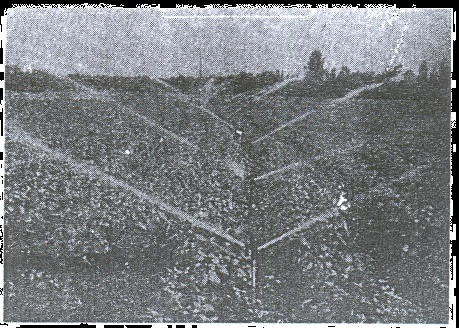Chapter: Civil : Water Resources and Irrigation Engineering : Irrigation Methods
Sprinkler Irrigation Method
In this farm â€'water application method, water is applied to the soil in the form of a spray through a network of pipes and pumps. It is a kind of an artificial rain and, therefore, gives very good results. It is a costly process and widely used in U.S.A. It can be used for all types of soils and for widely different topographies and slopes. It can advantageously be used for many crops, because it fulfils the normal requirement of uniform distribution of water. This method possesses great potentialities for irrigating areas in Rajasthan in India, where other types of surface or sub â€' surface irrigation are very difficult.

Figure: Photo view of a sprinkler system in operation (using a rotary head)
In spite of the numerous advantages which this method possesses over the other methods, it has not become popular in India for the simple reason that ours is a poor and a developing nation. This method is not only costly but requires a lot of technicalities. The correct design and efficient operation are very important for the success of this method. Special steps have to be taken for preventing entry of silt and debris, which are very harmful for the sprinkler equipment. Debris â€'choke nozzles; interfere with the application of water on the land; while the abrasive action of silt causes excessive wear on pump impellers, sprinkler nozzles, and bearings. The system is to be designed in such a way that the entire sprayed water seeps into the soil, and there is no run off from the irrigated area.
The conditions favouring and adoption of this method, are:
1. When the land topography is irregular, and hence unsuitable for surface irrigation.
2. When the land gradient is steeper, and soil is easily erodible.
3. When the land soil is excessively permeable, so as not to permit good water distribution by surface irrigation; or when the soil is highly impermeable.
4. When the water table is high.
5. When the area is such that the seasonal water requirement is low, such as near the coasts.
6. When the crops to be grown are such:
a. As to require humidity control, as in tobacco;
b. Crops having shallow roots; or
c. Crops requiring high and frequent irrigation.
7. When the water is available with difficulty and is scarce.
Types of sprinkler systems. A sprinkler system can be classified under three heads, as:
1. Permanent system;
2. Semipermanent system; and
3. Portable system.
Earlier, the fixed overhead perforate pipe installations were being used for sprinkler network; but with the advent of light weight steel pipes and quick couplers, portable systems have been designed.
In permanent system, pipes are permanently buried in such a way that they do not interfere with the farming operations. In the semi permanent system, the main lines are buried in the ground, while the laterals are portable. In portable system, the mains as well as laterals are portable. These portable networks can be moved from farm to farm.
In the sprinkler irrigation network, we have the mains and the submains, through which water under pressure is made to flow. Revolving sprinkler heads are then usually mounted on rising pipes attached to the laterals. The water jet comes out through the revolving sprinkler heads, with force. When sprinkler heads are not provided, perforations are made in the pipes, and they are provided with nozzles, through which water jets out and falls on the ground. Generally, such a perforated pipe system operates at low heads; whereas, the revolving heads sprinklers operate on high as well as low heads, depending upon the type of rotary head used.
The advantage of sprinkler irrigation are enumerated below:
(i) Seepage losses, which occur in earthen channels of surface irrigation methods, are completely eliminated. Moreover, only optimum quantity of water is used in this method.
(ii) Land leveling is not required, and thus avoiding removal top fertile soil, as happens in other surface irrigation methods.
(iii) No cultivation area is lost for making ditches, as happens in surface irrigation methods. It, thus, results in increasing about 16% of the cropped area.
(iv) In sprinkler system, the water is to be applied at a rate lesser than the infiltration capacity of the soil, and thus avoiding surface run, and its bad effects, such as loss of water, washing of top soil, etc.
(v) Fertilizers can be uniformly applied, because they are mixed with irrigation water itself.
(vi) This method leaches down salts and prevents waterlogging or salinity.
(vii) It is less labour oriented, nad hence useful where labour is costly and scarce.
(viii) Upto 80% efficiency can be achieved, i.e. upto 80% of applied wter can be storedin the root zone of plants.
The liminations of sprinkler irrigation nare also enumerated below:
(i) High winds may distort sprinkler pattern, causing nonuniform spreading of water on the crops.
(ii) In areas of high temperature and high wind velocity, considerable evaporation losses of water may take place.
(iii) They are not suited to crops requiring frequent and larger depths of irrigation, such as paddy.
(iv) Initial cost of the system is very high, and the system requires a high technical skill.
(v) Only sand and silt free water can be used, as otherwise pump impellers lifting such waters will get damaged.
(vi) It requires larger electrical power.
(vii) Heavy soil with poor intake cannot the irrigated efficiently.
(viii) A constant water supply is needed for commercial use of equipment.
Note: the widely known Indian commercial company which specializes in installing sprinkler irrigation Irrigationsystems, isEquipments‚Premie (Pvt
Delhi office also. This firm and its publications can be referred to, for specialized knowledge in this branch of field irrigation.
Related Topics